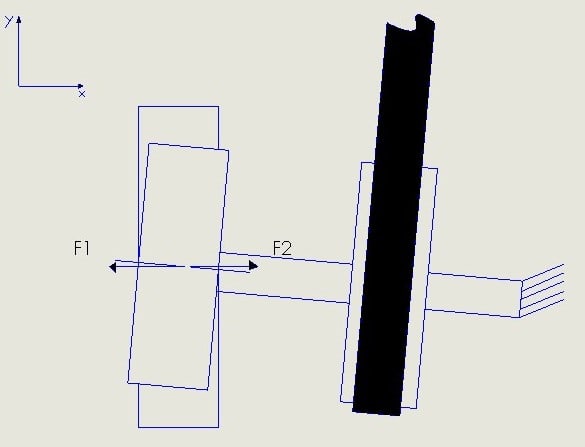thegasperus
Mechanical
- Oct 9, 2019
- 20
Dear fellow engineers!
I have a question for you all about some (hopefully) basic theory about drives. The problem is visualized in the lower figure and will describe the circumstances. The round parts in the figure are wheels. One of them is made of steel and the other is made of rubber - both have roller bearings around the middle axis for spinning. It is intended that friction coefficient is high between these two materials because the rotation is translated with friction. The problem appears (as I see it) when the upper wheel axis bend a little bit out of centerline of rotation compared with the lower wheels (see the figure - this is caused by the outer forces applied and conditions). This causes some reaction forces in the x direction between the wheels (F1 and F2 - depending on the direction of rotation). Meaning that in our case the steel wheel is being dragged in the x-direction, since its mounting is significantly weaker than the mounting of rubber wheel.

Basically my question is how to describe or where can I find any theory or examples on this kind of behavior? I would really like to somehow calculate those exact forces. And anyway I am only interested in the forces behavior in the +-x direction, although it would not harm to get to know the whole background. And just for me being completely convinced please confirm my physical model (the behavior).
Thanks upfront for your answers and best regards.
TheGasperus
I have a question for you all about some (hopefully) basic theory about drives. The problem is visualized in the lower figure and will describe the circumstances. The round parts in the figure are wheels. One of them is made of steel and the other is made of rubber - both have roller bearings around the middle axis for spinning. It is intended that friction coefficient is high between these two materials because the rotation is translated with friction. The problem appears (as I see it) when the upper wheel axis bend a little bit out of centerline of rotation compared with the lower wheels (see the figure - this is caused by the outer forces applied and conditions). This causes some reaction forces in the x direction between the wheels (F1 and F2 - depending on the direction of rotation). Meaning that in our case the steel wheel is being dragged in the x-direction, since its mounting is significantly weaker than the mounting of rubber wheel.

Basically my question is how to describe or where can I find any theory or examples on this kind of behavior? I would really like to somehow calculate those exact forces. And anyway I am only interested in the forces behavior in the +-x direction, although it would not harm to get to know the whole background. And just for me being completely convinced please confirm my physical model (the behavior).
Thanks upfront for your answers and best regards.
TheGasperus

